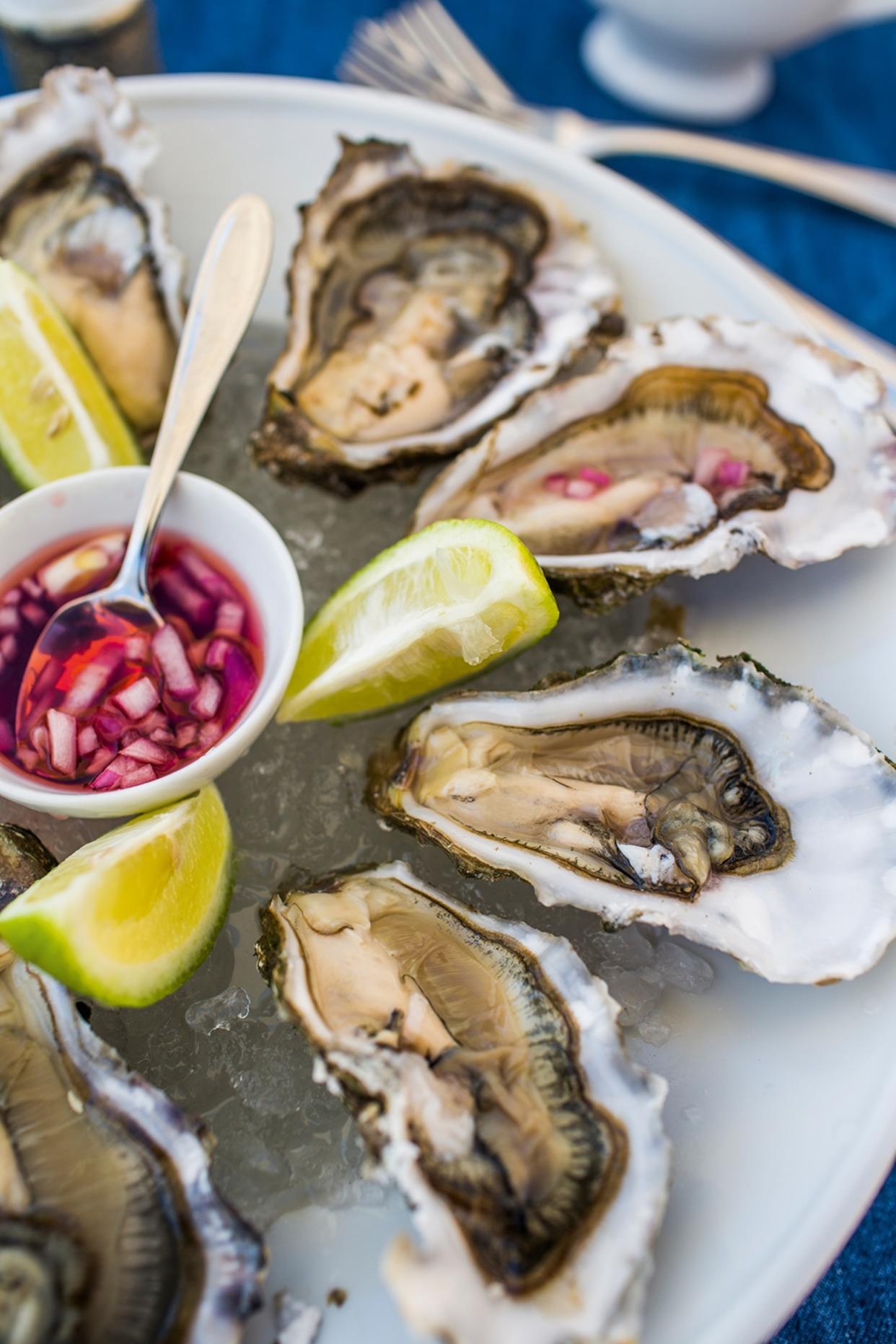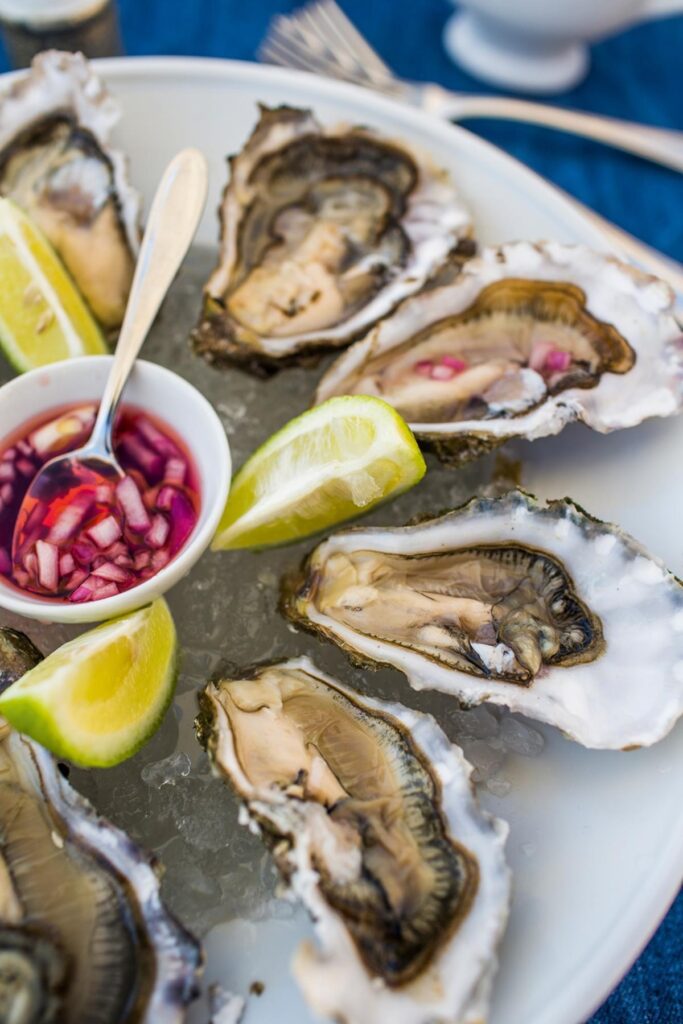
This article was produced by National Geographic Traveler (UK).
“Des huîtres? Of the houses?” The tanned seller who calls to me in French has a knife in one hand and a gnarled oyster in the other and beckons me to come and have a taste. It’s a crisp day in June and I’m standing in a row of whitewashed huts on the beach promenade in Oualidia, a city on Morocco’s Atlantic coast. Each room is topped by a Majorelle blue canopy that shades the display of huîtres (oysters), giant sea snails, clams and mussels, all arranged within the confines of plump lemons and small bottles of Tabasco sauce.
Unbeknownst to many, Morocco has a thriving oyster industry – and the community of Oualidia, on the west coast, is very proud of its main export. The town is a warren of sleepy streets that lead to fish cafes and a beachside surf hut where boards are rented. But what makes it special is the tidal lagoon where the molluscs will have been picked for me that morning. I can see it beyond the beach, stretching north, as the sea wave hangs over the water. The wetland reserve, protected from the Atlantic waves by a sandbar that hides the sea, is home to seven oyster farms and thousands of birds. The waters are so valuable that it is recognized as an area of international importance by the intergovernmental Ramsar Convention on Wetlands.
“There are two famous places for oysters in Morocco: Dakhla and Oualidia,” my guide, Nabil El Bahri, explains as we leave in a small boat for a closer look the next day. “The ones in Oualidia are tastier and delicious to eat straight from the water,” he adds. Nabil, dressed from head to toe in khaki like a professional twitcher, knows what he’s talking about. Before he worked here, he regularly went on children’s holidays to his grandmother.


Although few international travelers reach Oualidia, about 200 kilometers north of Essaouira, it has a long history as a summer destination for Moroccans. As we sail past spears of wood protruding from the lagoon – each marking the location of an underwater oyster bed – I keep an eye on an entertaining flotilla of brightly decorated boats ferrying children and women in hijabs to a long coastal beach. coastal side of the lagoon. Pedal boats and kayaks pass us, some with waving children. Smoke from makeshift grills on the sand disappears into the sea air; the atmosphere is exuberant.
As they cruise along, the beachgoers thin out and are replaced by simple white buildings used for cleaning the oysters, and neat rows of traps that form fishing gates at the front of each lot. Some have tables and chairs outside to lure in visitors moving across the water for marathons.
I quickly realize that we are not the only ones viewing the glassy lagoon’s natural larder. As we reach the headwaters we see a gray heron and spoonbills wading in a reed bed, low-flying terns and coots whose feet strike the water as they take off. “The temperature of the water and the food is good for the birds. There are worms, fish and shrimp for them,” Nabil explains, as we bump up to clamber ashore. After traveling about ten kilometers to the furthest reaches of the lagoon, Nabil is on a mission to find Oualidia’s most colorful inhabitants: flamingos.
We pass fields of wheat and corn and find a narrow path through a springy carpet of samphire and magenta-colored seagrasses to cross a series of abandoned salt pans. And there they are: a procession of long, bubble-gum pink bodies in the shallow water.
As we watch them sneak through the reeds, Nabil explains that Oualidia is a favorite meeting place for the birds on their journey from Spain to Senegal. “We know this because they are all tagged. We log the numbers as we see them.” It is full of facts; my favorite is that flamingos’ distinctive pink hue is due to their preferred diet of shrimp. With his eyes focused on the binoculars, Nabil pauses to look at them. “They are in good health. Their color is just fantastic,” he whispers.
The next morning, over breakfast at the lagoon-side La Sultana Oualidia hotel, I spot another long-legged resident wading through the water – a local mussel collector taking advantage of the low tide. They are in good company, with snow-white egrets digging among the collage of seaweed-draped rock pools. I’d like to do another slide as soon as the tide allows, but this time I’ll opt for the hotel’s kayak.


The absence of a boat motor means there is nothing to drown out the roar of the sea: always present, but invisible from the lagoon level. Attracted by the fierce sound, I stop on the beach opposite the hotel and clamber past discarded oyster shells from yesterday’s picnics to a pockmarked, rocky plateau to find it. The waves below are enormous; looking frothy and angry, a direct contrast to the lagoon behind me, which with the receding water has expanded into a handful of tranquil islands – a haven for oysters, farmers, birds and anyone lucky enough to find this place.
Published in the October 2024 issue National Geographic Traveler (UK).
To subscribe to National Geographic Traveler (UK) magazine click here. (Only available in certain countries).







